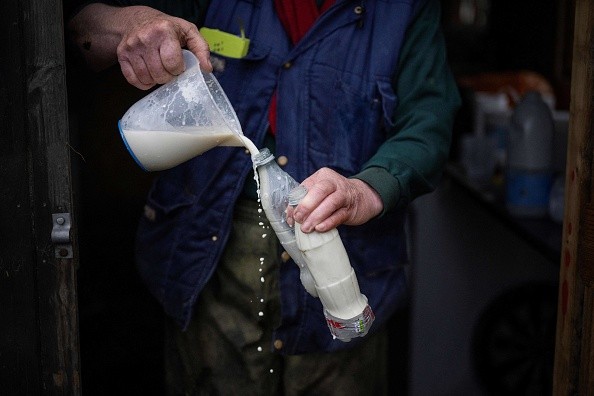According to the research, early farmers employed dairy products from a variety of animals, including cows, sheep, and goats, to reduce the lactose content in milk by turning it into cheese or other dairy products like yogurt.
During the Neolithic period until the Late Bronze Age, when the genetic mutation that allows adults to generate lactase, the enzyme that breaks down lactose in the body, became popular, practically everyone in Europe suffered from lactose intolerance.
Researchers examined the processing of dairy products in the Late Neolithic, discovering residues in pottery with a high curd content that indicated cheesemaking and showing that several dairy species were used.
Neolithic Ceramics Reveal Dairy Processing From the Milk Of Multiple Species
 (Photo : BEN STANSALL/AFP via Getty Images)
(Photo : BEN STANSALL/AFP via Getty Images)

According to Dr. Harry Robson from the University of York's Department of Archaeology, "These discoveries greatly advance our knowledge of the usage of dairy products by some of the first farmers in Central Europe," as per ScienceDaily.
While earlier studies have revealed that dairy products were extensively available in several regions of Europe throughout this time, this analysis of pottery provides the first concrete evidence for a diverse dairy herd, comprising cattle, sheep, and goats.
The ceramics and deposits from the Sławęcinek site in central Poland were examined by researchers and archaeologists from the Universities of York, Cambridge, Toruń and Kraków using a multi-stranded proteomic and lipid-analysis technique.
By examining the number of curd proteins, the new discovery shows that cheesemaking (and other dairy processes that enrich curds) can be directly detected.
Dairy use throughout the Neolithic is attested to by animal bones with kill patterns consistent with dairy herds, dairy lipids in pottery containers, and dairy proteins in prehistoric dental calculus or plaque, despite the common lactose intolerance at the time.
The proteomic analyses showed that the ancient residues closely resembled both the modern cheesemaking residues and cheese itself and not the entire milk, according to lead author Miranda Evans, a Ph.D. student at Cambridge's Department of Archaeology.
This indicated that the inhabitants of Sławęcinek practiced cheesemaking or another type of dairy processing that improved curds.
The discovery of both cow and sheep or goat bones at the location supported the theory that various species were utilized to make cheese.
This study showed how complementary lipid and proteomic analyses are, especially in understanding the use of the ceramic vessel over time, according to Dr. Jasmine Lundy from the Department of Archaeology.
For instance, using this, we could determine what foods were being made in the ceramics as well as how various treatments waterproofed or sealed the ceramics.
Also Read: New Neolithic Monument Discovered Near Stonehenge Using Remote Sensing Technology
What exactly is lactose intolerance and how prevalent is it?
The majority of newborns can digest lactose, as would be predicted given that lactase activity is normally highest at birth, as per Penn State Extension.
The main problem with digesting lactose is that about 75% of people undergo a progressive decline in lactase synthesis, notably between the ages of three and five, when levels fall to roughly 10% of what they were as infants.
Only approximately 25% of humans can still successfully digest lactose as they become older.
The main factor affecting a person's ability to produce lactase over time is not how frequently they consume lactose, but rather their genetic makeup.
Across ethnic groups and geographical areas of the world, there is a great deal of variation.
In Southeast Asia, lactase insufficiency affects more than 95% of adults, but in Scandinavia, it affects just approximately 10% of adults.
Only 1% of Dutch people were lactose intolerant, yet 100% of Native Americans had the condition.
A third of adolescents and adults in the United States are lactase non-persistent, which means they do not continue to produce the lactase enzyme into adulthood, according to the ethnic makeup of the country's population.
Physical symptoms that appear as a result of being unable to digest lactose are known as lactose intolerance.
Bowel discomfort, nausea, bloating, and diarrhea are typical signs of lactose intolerance.
Typically, the symptoms appear 30 minutes to 2 hours after intake.
Without actually being lactose intolerant, a lactase production deficiency is possible.
Unaware of it or not, some people who are lactose intolerant can tolerate lactose consumption.
Despite having insufficient lactase and being unable to digest lactose effectively, they can consume little amounts of it without experiencing any serious side effects.
Not every person with lactose digesting problems constantly exhibits symptoms.
Related article: Stonehenge Builders Ate Undercooked Cattle Organs During Winter Feasting; Parasitic Worms Found on Prehistoric Feces
© 2024 NatureWorldNews.com All rights reserved. Do not reproduce without permission.





